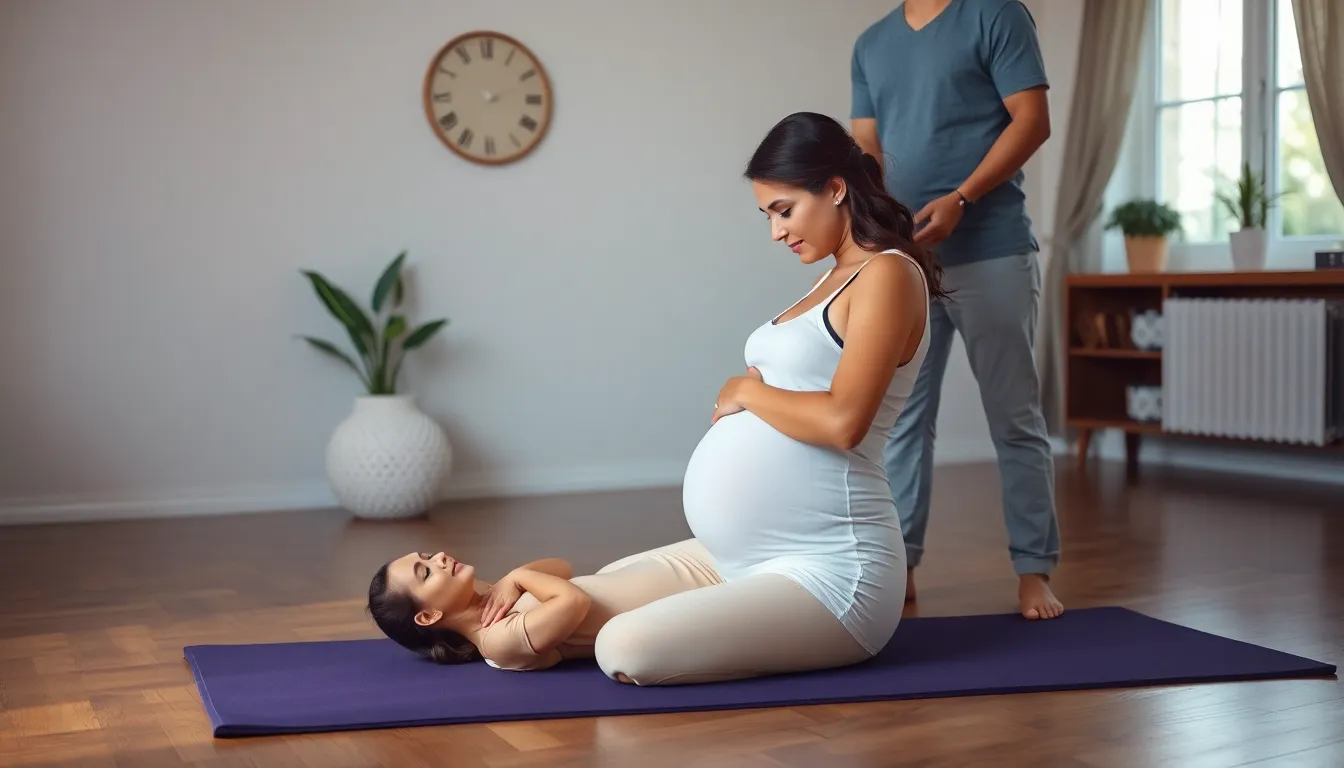When it comes to childbirth, every minute counts. Imagine a world where labor feels like a lightning-fast roller coaster ride instead of a marathon. It’s not just wishful thinking; certain labor positions can actually help speed up the delivery process. With the right moves, moms-to-be can channel their inner yoga master and dance their way to a quicker arrival for their little ones.
Table of Contents
ToggleOverview of Labor Positions
Labor positions play a crucial role in facilitating a quicker delivery process. Various stances can help align the baby and reduce discomfort.
Standing positions encourage gravity to assist with descent. Leaning against a wall or partner provides support. Squatting opens the pelvis and can increase the diameter for a smoother passage.
Kneeling offers an alternative that alleviates pressure on the back. Sitting on a birth ball promotes movement and enhances comfort during contractions.
Side-lying positions help regulate heart rates and make relaxation easier. Alternating sides can provide relief and maintain energy.
Rocking on hands and knees allows for shifting pressure points. This movement often helps lessen pain and may aid in repositioning the baby if needed.
Using the water can also promote comfort and relaxation during labor. Submerging in warm water offers buoyancy, which can ease strain on the body.
Supportive partners can help change positions effectively. Communication with caregivers ensures that the chosen positions align with individual needs and preferences.
Creating a dynamic labor experience encourages exploration of different postures. Trying various labor techniques can enhance progress and well-being during the childbirth journey.
Benefits of Optimizing Labor Positions

Optimizing labor positions during childbirth brings numerous advantages. A key benefit lies in improved comfort for expectant mothers.
Improved Comfort
Expectant mothers experience enhanced relaxation through specific labor positions. Adjusting positions can relieve pressure on the back and pelvis, mitigating discomfort during contractions. Leaning against a partner or a wall offers stable support and encourages deeper breathing. Utilizing a birth ball enhances mobility and provides a gentle way to handle contractions. These adjustments create a more soothing atmosphere, allowing mothers to focus on their breathing patterns. Comfort directly impacts emotional well-being during labor, leading to a more positive childbirth experience.
Enhanced Labor Progression
Optimizing labor positions also contributes to faster labor progression. Standing or squatting positions utilize gravity to assist with the baby’s descent. Movement promotes better fetal positioning and helps relieve pressure on key areas. Rocking on hands and knees can shift the baby’s position, aiding engagement with the cervix. Positions such as side-lying encourage better circulation, which can enhance contractions’ effectiveness. Utilizing these techniques aligns with natural labor dynamics, increasing the likelihood of a quicker delivery. Adjusting positions throughout labor allows mothers to engage actively in the process, promoting a sense of control over their childbirth journey.
Common Labor Positions for Shorter Delivery
Labor positions play a crucial role in enhancing the delivery process. Opting for specific stances can lead to a faster childbirth experience.
Sitting Positions
Sitting positions, such as on a birth ball or edge of a bed, encourage pelvic alignment. Patients can adjust their positioning to enhance comfort during contractions. Utilizing a birth ball allows for gentle movements that aid in relaxation. Proper support is vital; leaning slightly forward can create a sense of security and stability. Engaging the core in these positions supports better endurance, which can be beneficial during the labor phase.
Kneeling Positions
Kneeling positions provide effective support for expectant mothers. In this stance, individuals can shift their weight to find relief from back pressure. The pressure shift can promote optimal fetal positioning, encouraging easier descent through the birth canal. Kneeling also allows some to rest their forearms on a surface for added stability. The relaxation experienced during kneeling positions may contribute to reduced anxiety, enhancing overall labor comfort.
Standing Positions
Standing positions utilize gravity effectively for labor acceleration. While standing, individuals can sway their hips to relieve tension and promote comfort. Patients might find that leaning on a partner or a wall provides additional support. Changing the angle of the pelvis while standing aids in improving contractions’ intensity. Movement is important; walking or shifting weight from one leg to another can keep energy levels up during labor.
All Fours Position
All fours position helps shift pressure and encourages optimal fetal positioning. Practitioners note that this stance supports back pain relief, allowing for a more comfortable experience. Engaging in rhythmic rocking can enhance movement and circulation throughout the body. Further, this position facilitates natural repositioning of the baby, directly influencing delivery speed. Utilizing pillows for support enhances comfort while practicing the all fours position during labor.
Tips for Choosing the Right Labor Position
Selecting the appropriate labor position significantly affects the delivery experience. Trusting one’s body to guide movement helps find comfort. Consider the need for gravity when choosing positions, as standing or leaning can facilitate descent.
Assessing different positions aids in determining what feels best. Explore sitting on a birth ball for pelvic alignment and comfort during contractions. Kneeling offers relief from back pressure while promoting optimal fetal positioning.
Analyzing the effectiveness of movements can enhance energy levels. Swaying gently in a standing position utilizes gravity, actively supporting labor progression. Adjusting positions frequently prevents fatigue and allows the body to respond effectively.
Finding support from partners can make position changes easier and more efficient. Encouragement from a partner can foster confidence and promote a more positive labor experience. Communication with caregivers ensures chosen positions align with personal needs and circumstances.
Utilizing water during labor also provides comfort and relaxation. Immersion in warm water can soothe muscles and reduce tension. Integrating various techniques, like rocking on hands and knees, encourages better circulation and aids in fetal positioning.
Prioritizing comfort, movement, and effective communication enhances the labor experience. Exploring a range of positions empowers mothers to take control of their delivery journey. Adjusting positions based on individual preferences leads to a more satisfying and faster delivery process.
Exploring various labor positions can transform the childbirth experience for expectant mothers. By embracing movement and utilizing gravity, these positions not only enhance comfort but also promote a quicker delivery.
It’s essential for mothers to trust their instincts and communicate with their partners and caregivers about what feels best. Adopting different stances throughout labor can alleviate discomfort and keep energy levels up.
Ultimately, empowering mothers through knowledge of effective labor techniques can lead to a more satisfying journey into motherhood. Embracing these strategies can make all the difference during this significant life event.




